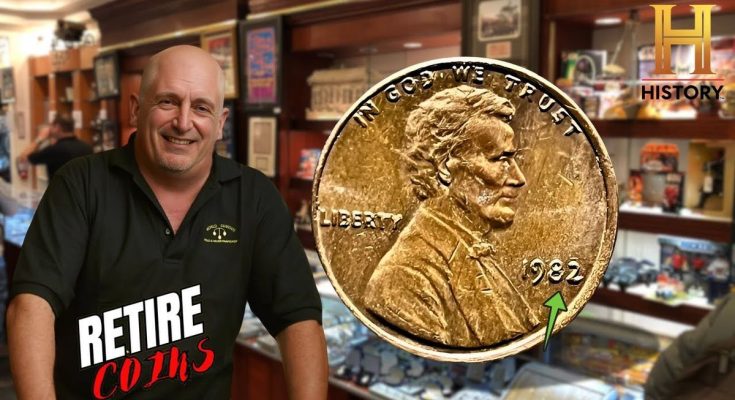🪙 Unveiling the Treasure: The Most Valuable U.S. Penny Coins
The humble U.S. penny, a coin most people dismiss as pocket change, holds a world of hidden value for coin collectors, or numismatists. While billions of cents are minted every year, certain rare and error coins have become numismatic legends, selling for hundreds of thousands, and even millions of dollars at auction.
The image captures the essence of this captivating pursuit: the potential for a fortune hiding in plain sight. It serves as a striking reminder that the penny in your change jar might be one of the “Key Dates” or “Error Varieties” that are highly sought after by collectors.
The King of Pennies: Errors and Anomalies
The most valuable pennies are often those that shouldn’t exist, created by accidental errors at the U.S. Mint. These anomalies represent moments where the strict process of coin production went awry, making the surviving coins exceptionally scarce.
- The 1943 Bronze Lincoln Cent (The Copper King): Arguably the most famous and valuable U.S. penny, its existence is a major mint error. During World War II, copper was vital for the war effort, so the Mint produced all 1943 pennies in zinc-coated steel. A small number of copper planchets (coin blanks) from 1942 were mistakenly struck in 1943. An authenticated 1943-D Bronze Cent from the Denver Mint holds an auction record of $1.7 million, and others regularly fetch six-figure prices.
- The 1944 Steel Lincoln Penny: This is the opposite error of the 1943 bronze. When the Mint switched back to bronze/copper in 1944, a few leftover steel planchets from 1943 were accidentally struck. A 1944-S Steel Cent from the San Francisco Mint is known to be worth over $700,000 in uncirculated condition.
- The 1969-S Doubled Die Obverse: This major minting error features strong, unmistakable doubling on the date and the inscriptions “LIBERTY” and “IN GOD WE TRUST.” While counterfeits are common, an authenticated, high-grade specimen has sold for over $125,000. Its dramatic appearance and extreme scarcity make it one of the most desirable post-1959 Lincoln Memorial cents.
- The 1955 Doubled Die Obverse: A more recognizable and popular doubled die error, the 1955 version shows distinct doubling on the date and lettering. Though more accessible than the 1969-S, its auction records still reach well into the tens of thousands of dollars for high-grade examples.
Key Dates of the Lincoln Wheat Cent (1909-1958)
The Lincoln Wheat Cent series, minted from 1909 to 1958, contains several “Key Dates”—coins with low mintage numbers that are valuable even without a minting error.
- 1909-S V.D.B.: The debut year of the Lincoln Cent stirred controversy over the prominent placement of the designer Victor David Brenner’s initials (V.D.B.) on the reverse. The initials were quickly removed, but the original production run from the San Francisco Mint was extremely limited, with only 484,000 struck. This coin is a must-have for serious collectors and can be worth well over $100,000 in top grades.
- 1914-D: With a mintage of only 1,193,000 pieces, the 1914-D from the Denver Mint is the third lowest-mintage coin in the entire series. Due to its scarcity, even circulated examples command high prices, and uncirculated coins have sold for hundreds of thousands.
- 1931-S: Struck during the Great Depression when demand for new coinage was low, this San Francisco-minted cent had a tiny mintage of only 866,000, making it the second lowest mintage in the series.
Modern Finds: The Post-1982 Hunt
Even in recent decades, valuable pennies have slipped into circulation, primarily due to the transition from a 95% copper composition to a cheaper, lighter copper-plated zinc composition in mid-1982.
- The 1982-D Small Date Copper Cent: In 1982, the Mint produced both “Large Date” and “Small Date” cents in both copper (3.11 grams) and zinc (2.5 grams). The extremely rare transitional error is a 1982-D Small Date cent mistakenly struck on a copper planchet. Only a few authenticated examples are known to exist, with one selling for $18,800 at auction, proving that the hunt for rare pennies continues today. Always use a sensitive scale to check the weight of your 1982 cents!
In conclusion, the world of valuable U.S. pennies is defined by rarity, historical context, and, most frequently, spectacular minting errors. From the famous 1943 copper cent to modern transitional errors, these one-cent treasures offer an exciting and profitable quest for anyone with a keen eye and a bit of luck. The key takeaway is simple: always check your change!



